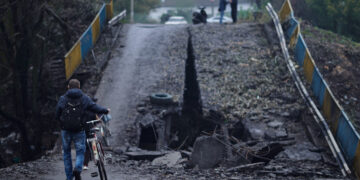Many rural areas across Europe have experienced a decline in their populations over recent decades. Drawing on new research from Spain, Fernando Merino, María A. Prats and Carlos-Javier Prieto-Sánchez show that the provision of digital communication infrastructure should be viewed as an important priority in efforts to prevent the depopulation of small and medium-sized municipalities.
The phenomenon of depopulation of rural areas is a trend that has been occurring in Spain for several decades due to the social and economic attractiveness of cities. In the 21st century, this process has become more pronounced, especially due to the ageing of the population.
This is not something new or different from what is happening elsewhere in Europe. According to a recent Eurostat report, a large number of rural areas in Europe are experiencing a continued reduction in their population, especially in the age groups of working-age adults (20-64 years) and young people (under 20 years).
Figure 1: Evolution of the Spanish municipal population between 2001 and 2017
Source: Comisionado del Gobierno frente al Reto Demográfico
It is well known that the lack of employment, public services, infrastructure and economic and social prospects has pushed the population in rural areas (especially young people) to settle in larger cities that offer a more encouraging quality of life and more favourable employment prospects. The role of these factors cannot be ignored or eliminated.
However, the spread of information and communications technology is changing how we live and work. It is claimed that these changes will make physical distance less important (or even negligible) to the location where individuals live and develop their careers given many work and leisure activities can now be carried out online.
From the countryside to the city
In a recent study, we have analysed the importance of physical connectivity and digital connectivity to attracting or maintaining the population of Spanish municipalities. Our study looked specifically at Spanish municipalities with populations of between 100 and 10,000 inhabitants.
In much of the interior of Spain, population densities resemble those of many areas of Scandinavia that are considered uninhabited. Yet, the Spanish phenomenon is different: it began with mass migration from the countryside to the city in the middle of the last century and has become more pronounced over the years. It is, therefore, a question of the loss of the (relative) attractiveness of these territories for the population.
The fact that the reduced population in these areas is the result of a process of population loss and not from having always lacked a significant population (as is the case in much of Scandinavia) has led to the term emptied Spain being preferred over empty Spain when referring to these areas. The phenomenon has aroused great interest and concern from various points of view.
On the one hand, there are what can be considered classic concerns. These include the readjustment of public services to account for the higher costs associated with providing services to a shrinking population, which can become a source of inequality. They also include the loss of value of public investments (such as schools, hospitals, roads and energy transport networks) and cultural assets (due to the difficult of caring for and maintaining historical heritage).
On the other hand, there are also sociocultural factors. The depopulation of part of a territory implies the loss of features that constitute the cultural heritage of a society. There is also a greater environmental impact given the population of rural areas contributes to maintaining biodiversity and the management of natural resources.
It is not surprising, therefore, that public policies have been called for to reverse this trend. Both national and European institutions have designed and implemented a set of measures to try to stop depopulation. The objective of these measures is to increase the attractiveness of areas at risk and mitigate the impacts of population loss.
Physical and digital connectivity
The rise of information technology means many of the activities that were previously carried out in person can now be done online. The COVID-19 pandemic has also had an important impact in shifting activities online. This raises the question of whether digital connectivity in rural areas can act as a substitute for physical connectivity in urban centres, where more services are provided, economic activity is greater and the quantity and variety of social activities is higher.
We find that, despite digital connectivity enabling many activities, the physical distance to urban centres continues to be an important factor in maintaining a local population. However, digital communication infrastructure, such as broadband, has also become a determining factor in shaping the future evolution of local populations.
Our research confirms digital connectivity is vital for both the wellbeing of local populations and the development of economic activities in a territory. The provision of digital communication infrastructure should therefore be viewed as a relevant factor in efforts to retain populations in small and medium-sized Spanish municipalities.
For more information, see the authors’ accompanying paper in Cities.
Note: This article gives the views of the authors, not the position of EUROPP – European Politics and Policy or the London School of Economics. Featured image credit: Natalia de la Rubia / Shutterstock.com










































Discussion about this post